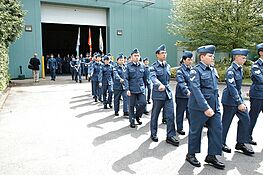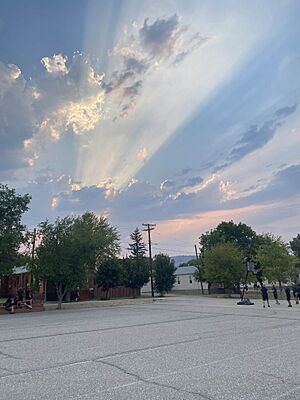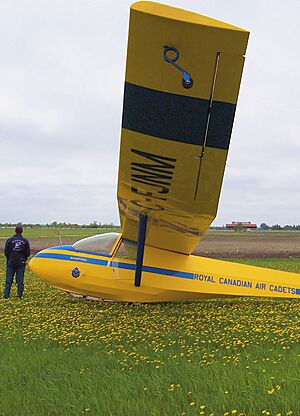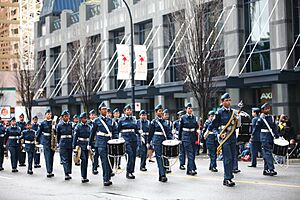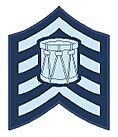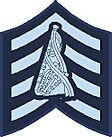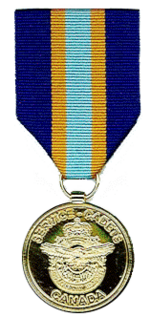Royal Canadian Air Cadets facts for kids
Quick facts for kids Royal Canadian Air Cadets |
|
|---|---|
| Cadets de l'Aviation royale du Canada (French) | |
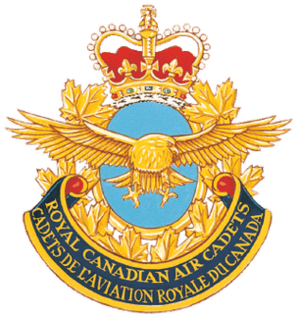
Badge of the Royal Canadian Air Cadets
|
|
| Active | April 9, 1941 – present |
| Country | Canada |
| Branch | Air |
| Type | Youth cadets organization |
| Size | 454 squadrons (more than 26,000 cadets) |
| Part of | Canadian Cadet Organizations |
| Headquarters | Ottawa, Ontario, Canada |
| Patron | Governor General of Canada |
| Motto(s) | To learn – to serve – to advance |
| March | Quick: "RCAF March Past" |
| Commanders | |
| Current commander |
Brigadier-General Dominique Brais |
| Formation Chief Warrant Officer | Chief Petty Officer 1st Class David Bliss |
| Insignia | |
| Ensign |  |
| Aircraft flown | |
| Trainer | Schweizer SGS 2-33A, Cessna L-19, Cessna 182, Bellanca Scout, Cessna 172 |
The Royal Canadian Air Cadets (French: Cadets de l'Aviation royale du Canada) is a fun and exciting program for young people in Canada. It's for anyone aged 12 to 18 who wants to learn new skills. This program is run by the Canadian Armed Forces (CAF) and gets money from the Canadian government.
The Air Cadet League of Canada (ACLC), a group of civilians, also helps out a lot. The Air Cadets are part of the "largest federally funded youth program" in Canada. This program also includes the Royal Canadian Sea Cadets and Royal Canadian Army Cadets. It's important to know that cadets are not part of the military. They don't have to join the Canadian Armed Forces later on.
The first Air Cadet groups started in 1941. They helped train young men during World War II. Today, the program helps young people become good citizens and leaders. It also encourages them to be physically fit. Plus, it helps them learn about aviation and the Canadian Armed Forces.
Most of the training happens at your local squadron during the school year. Some cadets also get to go to special summer training courses across Canada. A big part of the Air Cadet program is learning to fly gliders and airplanes. Many pilots in Canada started as Air Cadets. There are 454 squadrons all over the country. More than 26,000 Air Cadets are part of the program.
Contents
What Air Cadets Do
The main goal of the Cadet Program is to help young people grow. It teaches them to be good citizens and strong leaders. It also helps them stay active and learn about air activities. The Air Cadet motto is "To learn. To serve. To advance." A cadet named Robert Myles Colwell created this motto in 1966.
You can join the Air Cadets if you are between 12 and 18 years old. The Air Cadets use a rank system similar to the Royal Canadian Air Force. For example, they have Flight Corporals and Flight Sergeants. Cadets are not members of the Canadian Armed Forces. There is no pressure to join the military after the program. However, if cadets do join, they might get credit for their time in the program.
Adult leaders help run the program. Most of these leaders are officers from the Cadet Organizations Administration and Training Service. They are specially trained to teach cadets. Some are former cadets themselves.
The Canadian Cadet Organization works with the CAF and civilian groups. These groups include the Air Cadet League. Each local cadet group has a committee that helps raise money. The basic Air Cadet program is free. This includes uniforms and most activities. Local groups often get support from clubs like the Royal Canadian Legion. These groups help pay for things like buildings, insurance, and extra activities. Cadets and their parents often help with fundraising.
Air Cadet History
The Air Cadet program began during World War II. It was created to help train young men for the war. Before 1940, there were some unofficial groups. In 1939, Alan Duncan Bell-Irving and A.W. (Nick) Carter started the 1601 Air Force Cadet Wing in Vancouver. This group worked with the Department of National Defence.
In 1940, the Air Minister wanted a national group to train young men. This group would help meet the need for pilots during the war. On November 11, 1940, the Air Cadet League of Canada was officially formed. The first squadrons started in 1941. By 1942, there were 135 squadrons and 10,000 cadets. The program grew quickly. By 1944, it had 29,000 cadets in 374 squadrons.
At first, Air Cadets wore old uniforms from the RCAF. These were blue-grey wool uniforms. In 1943, they got a new uniform similar to the wartime RCAF uniform. After the war, the program changed. It focused more on citizenship and aviation. Summer courses and flying scholarships were introduced. More than 15,000 cadets have earned their private pilot licence through these scholarships.
In 1953, Prince Philip, Duke of Edinburgh, became the organization's Air Commodore-in-Chief. He held this role until his death in 2021.
In the late 1960s, a system of "air cadet wings" was stopped. All squadrons became independent. Senior cadets used to work as staff at summer camps. They were called "Call-out Corporals." This system was later changed to the "staff cadet" program. Now, senior cadets get advanced training and help the adult leaders.
In 1975, girls were officially allowed to join the Air Cadets. The uniform also changed. It went from wool to a rifle green safari style. In the mid-1980s, a new air force blue uniform was issued. Today, the Royal Canadian Air Cadets has about 23,000 members in 456 squadrons. It is a diverse program with many boys and girls.
Local Training
Each squadron meets one night a week. This is called a "parade night." During this time, cadets learn many things. The program lasts six years. It teaches about citizenship, leadership, survival training, and aviation basics. Older cadets (in their fifth year or more) can teach younger cadets. Local training runs from September to June.
Besides weekly training, cadets can join extra activities. These include band, marksmanship (shooting air rifles), biathlon, military drill, and first aid. Many of these activities have competitions at different levels. Cadets also go on weekend exercises. They might do survival training or participate in Remembrance Day ceremonies. They can also go on familiarization flights. Some squadrons also take part in community events like parades.
How Training Works
A new training system started in 2008. It uses new teaching materials and modern ways to help young people learn. This system helps connect the Air, Sea, and Army Cadet programs.
The program recognizes that young people (12-18) learn in different ways. Younger cadets learn best by doing things. Older cadets learn more about solving problems and thinking abstractly. The training methods change for each age group.
Squadrons have mandatory training activities. They can also choose extra activities based on what cadets are interested in. The program is introduced one year at a time. For example, the new Level 5 was introduced in 2012. Cadets already in the old system finished their training that way. This program will soon be updated again.
Training Levels
Air Cadets work through five training levels. Each level usually takes ten months to complete. If a cadet is 14 or older, they can finish Levels 1 and 2 in one year. When cadets complete a level, they get a special badge. As cadets get older, they learn to take on more responsibility. They might even teach other cadets.
Since 2022, a new training called PHASE (Promoting Healthy And Safe Experiences) has been added. In 2024, Level 5 and beyond were replaced with the ALP (Advanced Leadership Program). This program helps senior cadets improve their leadership skills.
| Level One | Level Two | Level Three |
|---|---|---|
To achieve Level One a cadet must satisfactorily complete the following first year performance objectives:
|
To achieve Level Two a cadet must satisfactorily complete the following second year performance objectives:
|
To achieve Level Three a cadet must satisfactorily complete the following third year performance objectives
|
| Level Four | Level Five | Onwards |
|---|---|---|
To achieve Level Four a cadet must satisfactorily complete the following fourth year performance objectives
|
To achieve Level Five a cadet must satisfactorily complete the following fifth year performance objectives
|
|
Extra Training Groups
Many squadrons have special teams or groups for extra training. Here are some examples:
- Drill Team: Cadets practice marching and complex drill moves. They might join a flag party or compete.
- Marksmanship Team: Cadets learn to shoot air rifles at targets. They can compete in shooting competitions.
- Military Band: Cadets learn to play brass, woodwind, or percussion instruments. They also learn special drill moves.
- Pipe Band: Cadets learn to play bagpipes or drums. They also learn special drill moves.
- Biathlon Team: Cadets learn to run or ski cross-country and shoot targets. They can compete in biathlon events.
- Ground School: Cadets learn the basics of aviation. This helps them prepare for glider or pilot training courses.
Summer Training
Air Cadets can also train during the summer. They can go to a Cadet Training Centre (CTC) or take national courses.
Cadet Training Centres
A Cadet Training Centre (CTC) is a place where cadets from all three elements (Sea, Army, Air) go for in-person summer training. Cadets can attend a CTC after finishing their second year of local training. These centres offer courses that help cadets develop leadership skills and confidence. Most courses are either two-week introductory programs or four-week instructor courses. These longer courses prepare cadets to be leaders and teachers in the program.
In-Person Summer Courses
In-person CTC courses are usually either introduction courses or instructor courses. Introduction courses are typically two weeks long. They help cadets build personal skills and basic knowledge in a specific area. Instructor courses are four weeks long. They focus on leadership, teaching skills, and specific subject knowledge. Cadets who finish instructor courses are expected to teach and lead at their home squadrons. When a cadet successfully completes a course, they get a badge for their uniform.
| Course | Length | Prerequisites | Element | Location |
|---|---|---|---|---|
| Introduction to Marksmanship (ITM) | 2 Weeks | Proficiency level 2+ | Common | Argonaut CTC, Blackdown CTC, Valcartier CTC, Vernon CTC |
| Air Rifle Marksmanship Instructor (ARMI) | 4 Weeks | Proficiency level 3+ | Common | Argonaut CTC, Blackdown CTC, Valcartier CTC, Vernon CTC, Whitehorse CTC |
| Introduction to Drill and Ceremonial (ITDC) | 2 Weeks | Proficiency level 2+ | Common | Argonaut CTC, Blackdown, Rocky Mountain CTC, CTC, Valcartier CTC, Vernon CTC |
| Drill and Ceremonial Instructor Course (DCI) | 4 Weeks | Proficiency level 3+ | Common | Argonaut CTC, Blackdown, Rocky Mountain CTC, CTC, Valcartier CTC, Vernon CTC, Whitehorse CTC |
| Introduction to Fitness and Sports (ITFS) | 2 Weeks | Proficiency level 2+ | Common | Blackdown CTC, Greenwood CTC, Valcartier CTC, Vernon CTC |
| Fitness and Sports Instructor Course (FSI) | 4 Weeks | Proficiency level 3+ | Common | Blackdown CTC, Greenwood CTC, Valcartier CTC, Vernon CTC |
| Introduction to Military Band (ITMB) | 2 Weeks | Proficiency level 2+ | Common | Blackdown CTC, HMCS Quadra CTC, Valcartier CTC |
| Military Band Musician (MB) | 4 Weeks | Proficiency level 3+ / Musician Level II | Common | Blackdown CTC, HMCS Quadra CTC, Valcartier CTC |
| Introduction to Pipe Band (ITPB) | 2 Weeks | Proficiency level 2+ | Common | Blackdown CTC, Rocky Mountain CTC |
| Pipe Band Musician (PB) | 4 Weeks | Proficiency level 3+ / Pipes and Drums Level II | Common | Blackdown CTC, Rocky Mountain CTC |
| Aviation Technology and Aerospace (ATA) | 2 Weeks | Proficiency level 2+ | Air | Bagotville CTC, Blackdown CTC, Cold Lake CTC, Greenwood CTC, HMCS Quadra CTC |
| Advanced Aviation Course (AA) | 4 Weeks | Proficiency level 3+ | Air | Bagotville CTC, Blackdown CTC, Cold Lake CTC, Greenwood CTC, HMCS Quadra CTC |
| Glider Pilot Training Course (GPTC) | 6 - 7 Weeks | Proficiency level 3+ / 16 Years of age by Sept 1 / Vaild TCCA Cat 3 Medical | Air | St-Jean CTC, Trenton CTC |
| Power Pilot Training Course (PPTC) | 7 Weeks | Proficiency level 4+ / 17 Years of age by Sept 1 / Vaild TCCA Cat 3 Medical | Air | Argonaut CTC, Bagotville CTC, HMCS Quadra CTC, St-Jean CTC |
| Introduction to Survival (ITS) | 2 Weeks | Proficiency level 2+ | Air | Argonaut CTC, Blackdown CTC, Cold Lake CTC, Valcartier CTC, Vernon CTC |
| Survival Instructor Course (SI) | 4 Weeks | Proficiency level 3+ | Air | Argonaut CTC, Blackdown CTC, Cold Lake CTC, Valcartier CTC, Whitehorse CTC |
Cadet Training Centre Locations
Cadet Training Centres (CTCs) are special places that run during the summer. They offer advanced training for cadets across Canada. The Canadian Armed Forces helps manage these centres. CTCs provide structured courses in leadership, teaching, and technical skills. Cadets also get to meet other cadets from all over the country.
| CTC |
|
Region | Primary
Element |
First Year | Language | Notes |
|---|---|---|---|---|---|---|
| Argonaut CTC | 5 CDSB Gagetown | Atlantic | Army | 1972 | English | |
| Bagotville CTC | CFB Bagotville | Eastern | Sea | 1969 | French | |
| Blackdown CTC | CFB Borden | Central | Army | 1994 | Bilingual | |
| Cold Lake CTC | CFB Cold Lake | Northwest | Air | 1973 | English | |
| Greenwood CTC | CFB Greenwood | Atlantic | Air | English | ||
| HMCS Ontario CTC | CFB Kingston | Central | Sea | 1981 | English | |
| HMCS Quadra CTC | CFB Comox | Pacific | Sea | 1952 | English | |
| Rocky Mountain CTC | Cochrane, Alberta | Northwest | Army | 1999 | English | |
| St-Jean CTC | RMC Saint-Jean | Eastern | Air | 1975 | French | |
| Trenton CTC | CFB Trenton | Central | Army | 1929 | English | |
| Valcartier CTC | 2 CDSB Valcartier | Eastern | Army | 1968 | French | |
| Vernon CTC | Vernon, British Columbia | Pacific | Army | 1949 | English | |
| Whitehorse CTC | Whitehorse, Yukon | Northwest | Army | 1985 | English |
| CTC | Location | Region | Year Closed | Reason for closing |
|---|---|---|---|---|
| Albert Head Air Cadet Summer Training Centre | CFB Esquimalt | Pacific | 2022 | Cadet Program Rescope, returned to Maritime Forces Pacific |
| Comox Cadet Flying Training Centre | CFB Comox | Pacific | 2022 | Cadet Program Rescope, merged with HMCS Quadra CTC |
| Penhold Air Cadet Summer Training Centre | RCAF Station Penhold | Northwest | 2014 | High leasing and infrastructure costs |
| Gimli Cadet Flying Training Centre | Gimli, Manitoba | Northwest | 2022 | Cadet Program Rescope |
| Mountainview Cadet Flying Training Centre | CFB Trenton | Central | 2022 | Cadet Program Rescope, merged with Trenton CTC |
| Debert Cadet Flying Training Centre | CFS Debert | Atlanic | 2022 | Cadet Program Rescope |
Online Learning Centre
The Cadet Technology and Digital Learning Centre (TDLC) is an online training program. Cadets can take interactive courses from home during the summer. These courses focus on digital skills and leadership. They cover topics like cyber safety, drone operation, and coding. The program is flexible and offers valuable technical skills.
| Course | Requirements | Duration | Notes |
|---|---|---|---|
| Cyber Safety and Security Team Leader (CSSTL) | Proficiency level 2+ / Laptop / Computer able to operate VMware player | 2 Weeks | |
| Support Services Team Leader (SSTL) | Proficiency level 2+ / Digital Camera | 2 Weeks | Recommended for Proficiency Level 3+ |
| Small Craft Coxswain (SCC) | Proficiency level 2+ | 2 Weeks | Recommended for Proficiency Level 3+ |
| Basic Microdrone Operator (BMDO) | Proficiency level 2+ | 2 Weeks | |
| Nova Quest (NQ) | Proficiency level 2+ | 2 Weeks | |
| Basic Coder (BC) | Proficiency level 2+ | 2 Weeks |
Advanced Summer Training
Advanced Summer Training is for cadets who have already completed basic summer training. These programs are more intense and selective. They focus on advanced leadership and technical skills. This includes instructor courses, exchanges, and staff cadet positions. Cadets often need to apply and be interviewed for these programs. Finishing advanced training helps cadets take on bigger roles in their squadron.
Staff Cadets
Staff Cadets (SCdt) are experienced cadets who become leaders and instructors during summer training. They are usually 16 or older. They are chosen for their skills and leadership potential. Staff Cadets help supervise, train, and guide younger cadets. They are role models and gain valuable experience. They can work as instructors, leaders, or in support roles. Staff Cadets receive a weekly training payment. They also gain qualifications that help them in and out of the cadet program.
Staff Cadet Requirements
- Be 16 years old before the first day of work and not 19 before the last day.
- Have completed Phase 3/Silver Star/Level 3 by the end of the 2024-2025 training year.
- Be at least a Petty Officer 2nd Class/Sergeant rank.
- Have a social insurance number and a personal bank account.
Cadet Training Centre Staff Roles
Staff Cadets work in many different roles at Cadet Training Centres. They help with training, support, and command. They supervise cadets, teach lessons, and lead activities. Each CTC has a senior cadet called a Warrant Officer 1st Class. This cadet is the top cadet leader at the camp. Individual courses are usually led by a Warrant Officer 2nd Class. Each group (flight) has a Flight Sergeant and three Sergeants as instructors.
Training Roles
Staff Cadets in training roles are instructors. They teach and lead cadets in daily activities. Training staff are usually Sergeants or Flight Sergeants.
Support Roles
Every Cadet Training Centre has Staff Cadets in support roles. They help with things like operations, administration, supply, and sports.
Senior Cadet Leaders
Senior Cadet Staff hold important leadership positions. They oversee courses and the whole camp. The most senior cadet at the CTC is a Warrant Officer 1st Class. They are the top cadet leader for the entire centre.
Digital Internship
A Digital Internship at a Cadet Training Centre means you are on-site but focus on technology. You help with IT tasks like setting up computers and networks.
Online Learning Staff
An eLearning Staff Cadet helps with virtual summer training courses from home. They use online tools to teach junior cadets across Canada.
National Cadet Advisory Council
The National Cadet Advisory Council (NCAC) is a group of senior cadets from across Canada. They give ideas and feedback to the Department of National Defence about the cadet program. This council lets cadets share their opinions and help improve the program. Members are chosen for their leadership and experience.
Staff Cadet Pay
Staff Cadets get paid based on the Canadian Armed Forces Reserve Officer Cadets salary. Higher ranks receive more pay.
| Rank | Percentage | Daily Pay (as of 2025) |
|---|---|---|
| Cadet Flight Corporal | 72% | $96.00 |
| Cadet Sergeant | 78% | $104.00 |
| Cadet Flight Sergeant | 84% | $112.00 |
| Cadet Warrant Officer 2nd | 90% | $120.00 |
| Cadet Warrant Officer 1st Class | 96% | $128.00 |
Flying
Every spring and fall, about 22,000 Air Cadets get to fly gliders. This happens at gliding centres across Canada. Each summer, 320 cadets earn a Transport Canada Glider Pilot Licence. Another 250 cadets earn a Private Pilot Licence. The Air Cadet Gliding Program does about 60,000 glider flights each year. They use Schweizer SGS 2-33 gliders.
The gliders and tow planes are owned by the Air Cadet League of Canada. The Canadian Armed Forces helps maintain them. CAF pilots and civilian instructors fly these aircraft to train cadets. For the Private Pilot Training Course, cadets go to private flight schools. They fly different planes like the Cessna 152 or Cessna 172.
Aircraft Used
| Make/Model | Type | Manufacturer | Origins |
|---|---|---|---|
| Schweizer SGS 2-33A | Glider | Schweizer Aircraft | United States |
| Cessna L-19 Superdog | Tow Plane | Cessna | United States |
| Cessna 182 | Tow Plane | Cessna | United States |
| Bellanca Scout | Tow Plane | Bellanca | United States |
Uniforms
Royal Canadian Air Cadets get uniforms to wear. These uniforms are like those worn by the Royal Canadian Air Force. They include a cap, shirt, tie, jacket, pants, and boots. Cadets wear rank badges, name tags, and special pins. They are expected to keep their uniforms neat and tidy.
| Category | Order of Dress | When Worn |
|---|---|---|
| Ceremonial Dress | C1 - Ceremonial Dress | A formal uniform, worn for special events like:
|
| C1H - Highland Dress | A formal uniform for Highland and kilted Irish units and pipe bands. | |
| C1H - Highland Dress Short Sleeve | When allowed by the squadron commanding officer. | |
| Mess Dress | C2 - Mess Dress | An optional formal uniform worn for:
|
| C2H - Highland Mess Dress | When allowed by the squadron commanding officer. | |
| Service Dress | C3 - Service Dress | For routine daily duties. |
| C3A - Open Coller | When allowed by the squadron commanding officer. | |
| C3B - Summer Dress | When allowed by the squadron commanding officer. | |
| C3C - Travel Dress | When allowed by the squadron commanding officer. | |
| C3H - Highland Service Dress | When allowed by the squadron commanding officer. | |
| Training Dress | C5 - Field Training Uniform (FTU) | A practical uniform worn for specific training like marksmanship or field training. |
| C5A - FTU Dressed Down | A practical uniform worn for specific training like marksmanship or field training. | |
| C5B - Flight Suit | A practical uniform worn for flying or other specific activities. | |
| C5C - PT Gear | When allowed by the training centre or squadron commanding officer. |
Uniform Accessories
Air Cadets can wear extra items on their uniform. These depend on their role, like being in a band or a flag party.
Pace Sticks and Drill Canes
Pace Sticks are special tools used by senior cadets. They show leadership and authority in drill. They help measure marching steps. Only the Squadron Warrant Officer and Squadron Chief Warrant Officer can carry a pace stick.
Drill Canes are also symbolic tools carried by senior cadets. They show authority and discipline. They are mainly used by Army Cadets. However, at summer training centres, senior Sea Cadets and Air Cadets can also carry them.
Lanyards, Gaiters, and Cotton Gloves
Lanyards, Gaiters, and Cotton Gloves are ceremonial accessories. Air Cadets wear them during formal parades. Lanyards are often worn by staff cadets. Gaiters are less common but can be worn for ceremonial drill. Cotton gloves are worn by flag parties and drill teams. They make the uniform look sharper.
White Webbing
White Webbing is a ceremonial accessory. Air Cadets wear it during formal parades or duties like flag party. It includes a white belt and straps. It makes the uniform look more disciplined.
Brassards Brassards are cloth armbands worn on the upper sleeve. They show qualification badges, rank, and awards. They help keep the main uniform clean. They are mostly worn at Cadet Training Centres to show rank.
Remembrance Day Symbols The Remembrance Day poppy can be worn on all uniforms from the last Friday of October until November 11th. It is worn on the left pocket flap of the shirt and left chest of the jacket.
Insignia Badges
Insignia Badges on Air Cadet uniforms show rank, qualifications, and achievements. They recognize a cadet's skills and progress.
Proficiency Badges
Proficiency Badges show a cadet's rank, qualifications, and achievements. They are worn on the uniform in specific places.
| Type | Level | Badge |
|---|---|---|
| Fitness | Bronze | Badge indicating I |
| Sliver | Badge indicating II | |
| Gold | Badge indicating III | |
| Excellence | Badge with a Maple Leaf | |
| Music | Basic | Music note |
| Level I | Music note with I | |
| Level II | Music note with II | |
| Level III | Music note with III | |
| Level IV | Music note with IV | |
| Level V | Music note with V | |
| Marksmanship | Marksman | Crossed Rifles with I |
| Marksman First Class | Crossed Rifles with II | |
| Expert Marksman | Crossed Rifles with III | |
| Distinguished Marksman | Crossed Rifles with IV | |
| First Aid | Emergency First Aid | First Aid Cross with I |
| Standard First Aid | First Aid Cross with II |
Participation and Competition Badges
Participation and Competition Insignia show that Air Cadets have taken part in sports, marksmanship, music, and other activities. They show a cadet's extra efforts.
| Type | Level | Badge / Pin |
|---|---|---|
| Staff and Exchange | Staff Cadet | Maple Leaf with Reef |
| International Exchange | Globe | |
| ACLC Effective Speaking Competition | Zone Bronze | Bronze Air Cadet Speaking Pin |
| Provincial Silver | Silver Air Cadet Speaking Pin | |
| National Gold | Gold Air Cadet Speaking Pin | |
| Marksmanship Compeition | Marksmanship Zone Competition Bronze | Bronze Cadet Prone Shooter |
| Marksmanship Provincial Competition Silver | Silver Cadet Prone Shooter | |
| Marksmanship National Competition Gold | Gold Cadet Prone Shooter | |
| Vanplew and Clément Tremblay Awards | Gold Cadet Prone Shooter in a Reef | |
| Biathlon Compeition | Biathlon Zone Competition Bronze | Bronze Cadet Skiing |
| Biathlon Provincial Competition Silver | Silver Cadet Skiing | |
| Biathlon National Competition Gold | Gold Cadet Skiing | |
| Myriam Bédard, Nikki Keddie and Jean-Philippe
Le Guellec Awards |
Gold Cadet Skiing in a Reef |
Ranks
When you join the Air Cadets, you start as a "Cadet" (Cdt). You can get promoted to higher ranks by meeting certain standards. These standards make sure all cadets at a certain rank have similar skills.
Cadets start getting leadership roles when they reach the rank of Flight Corporal. Flight Corporals can lead small groups of younger cadets. Sergeants help with daily squadron activities. They teach lessons and help with tasks like attendance. Flight Sergeants lead larger groups (flights). Warrant Officers 2nd Class work closely with adult leaders. They help with administration, training, and public relations. Warrant Officers 1st Class report directly to the squadron's Commanding Officer. They oversee all squadron activities.
The official name of each rank includes "cadet" (e.g., cadet corporal). But usually, people just say "corporal." If you need to tell the difference between a cadet and a Canadian Forces member, you would say "cadet corporal."
Merit Review Board Process
To be promoted to Flight Sergeant (FSgt), Warrant Officer Second Class (WO2), or Warrant Officer First Class (WO1), cadets need to be recommended by a Merit Review Board (MRB). This board has three to five members. The squadron's commanding officer leads the board.
The MRB has two parts: reviewing the cadet's file and an interview. The file review looks at things like attendance, training performance, and awards. After the file review, cadets are invited for an interview. All cadets are asked the same questions. They get these questions up to 72 hours before the interview. Cadets might be asked about their goals, leadership experiences, and how they would handle different situations. After both parts, the board decides if the cadet should be promoted.
| Junior Cadets (Air Cadet - Flight Corporal) | |||
|---|---|---|---|
| CDT 1 | CDT 2 | CDT 3 | CDT 4 |
| Cadet (Cdt) | Leading Air Cadet (LAC) | Cadet Corporal (Cpl) | Cadet Flight Corporal (FCpl) |
| No insignia | One double-bladed Propeller. | a two-bar Chevron | A two-bar Chevron surmounted by a St Edward's Crown |
| The rank of Air Cadet is granted upon enrollment. Those wishing to enroll must be at least 12 years of age and younger than 19 years of age. |
In order to be promoted to Leading Air Cadet, a cadet must:
|
In order to be promoted to Corporal, a cadet must:
|
In order to be promoted to Flight Corporal, a cadet must:
|
| Senior Cadets (Sergeant - Warrant Officer First Class) | |||
| CDT 5 | CDT 6 | CDT 7 | CDT 8 |
| Cadet Sergeant (Sgt) | Cadet Flight Sergeant (FSgt) | Cadet Warrant Officer Second Class (WO2) | Cadet Warrant Officer First Class (WO1) |
| A three-bar Chevron | A three-bar Chevron surmounted by a St Edward's Crown | A St Edward's Crown within a wreath of Maple leaves | A simplified version of the 1957 Coat of arms of canada |
|
In order to be promoted to Sergeant, a cadet must:
|
In order to be promoted to Flight Sergeant, a cadet must:
|
In order to be promoted to Warrant Officer Second Class, a cadet must:
|
In order to be promoted to Warrant Officer First Class, a cadet must:
Upon being promoted to WO1, the cadet is henceforth referred to as the Chief/Warrant/Squadron Commander of their Squadron, should they not already hold that position. Promotion to Warrant Officer 1st Class may be considered the pinnacle of an Air Cadet's service. Prior to 1976, the size of the squadron dictated the top rank available and many squadrons were ineligible to carry a WO1 on their establishment effectively capping promotion at WO2 for the squadron's ranking cadet. Squadrons are limited to one Warrant Officer First Class. The Warrant Officer First Class position must be vacant for a cadet to be promoted. An existing Warrant Officer First Class (or equivalent) may keep their rank if they transfer to another corps or squadron. |
As of October 10, 2023, cadets no longer need to do a fitness assessment to be promoted. Also, promotions to ranks below Warrant Officer Second Class no longer require a minimum standard in leadership training.
Cadet Appointments
As cadets move up in rank, they can take on leadership roles once they reach Sergeant. Squadron officers decide who is eligible for these roles. They tell the cadet about the appointment and give them training. More senior cadets also offer advice. These appointments can be in training support or command positions.
| Department | Rank | Title | Abbrev. |
|---|---|---|---|
| Administration | Sgt | Administration Sergeant | Admin Sgt |
| FSgt | Administration Flight Sergeant | Admin FSgt | |
| WO2 | Administration Warrant Officer Second Class | Admin WO2 | |
| Supply | Sgt | Supply Sergeant | Sup Sgt |
| Sgt | Cadet Canteen Assistant | Cdt Canteen A | |
| FSgt | Supply Flight Sergeant | Sup FSgt | |
| WO2 | Supply Warrant Officer Second Class | Sup WO2 | |
| Public Affairs | Sgt | Cadet Correspondent Assistant | C Corr A |
| FSgt | Cadet Correspondent | C Corr |
| Department | Rank | Title | Abbrev. |
|---|---|---|---|
| Band | Sgt | Band Sergeant | Band Sgt |
| FSgt | Music Instructor | Mus Instr | |
| WO2 | Band Warrant Officer Second Class | Band WO2 | |
| Standards | Sgt | Drill and Ceremonial Assistant | D&C A |
| FSgt | Standards Flight Sergeant | Stds FSgt | |
| WO2 | Standards Warrant Officer Second Class | Stds WO2 | |
| Instruction | Sgt | Instructor | Instr |
| Sgt | Cadet Marksmanship Coach | Cdt Marks C | |
| Sgt | Cadet Biathlon Coach | Cdt Biathlon C | |
| FSgt | Survival Instructor | SI | |
| FSgt | Fitness and Sports Instructor | FSI | |
| FSgt | Drill and Ceremonial Instructor | DCI | |
| Training | Sgt | Cadet Training Assistant | Cdt Trg A |
| WO2 | Training Warrant Officer Second Class | Trg WO2 |
| Rank | Title | Abbrev. |
|---|---|---|
| Sgt | Section Commander | Sect Comm |
| Sgt | Flight Second in Command | Flt 2iC |
| Sgt | Flag Party Second in Command | FP 2iC |
| FSgt | Flight Sergeant | Flt Sgt |
| WO2 | Squadron Warrant Officer | SWO |
| WO1 | Squadron Chief Warrant Officer | Sqn CWO |
Music Appointments
Squadrons can create cadet bands if they want to. They need to talk to the sponsoring committee about getting instruments. There are two types of bands: military bands and pipe bands. Military bands use woodwind, brass, and percussion instruments. Pipe bands use pipes and drums. Cadets can earn music proficiency badges for their uniform.
The squadron's Commanding Officer decides who can be a Drum Major or Pipe Major. To get these roles, cadets need to show skills in band drill and commands. They also need to have Music Proficiency Level 2 and be at least a Flight Corporal. Only one cadet can be a Drum Major or Pipe Major in a squadron at a time.
| Drum Major | Pipe Major |
|---|---|
|
|
Honours and Awards
The Canadian Cadet Movement has its own system for honours and awards. Cadets can earn these for bravery, good citizenship, service, or great performance in summer training. Cadets can also wear any official Canadian medals they have received.
Some awards are for all three cadet elements (Sea, Army, Air). Others are just for Air Cadets. If a cadet moves from one element to another, they can still wear medals from their previous service. Here are some awards Air Cadets can earn:
| Medal | Image | Description |
|---|---|---|
| Cadet Medal for Bravery |
.
|
Given for brave actions in dangerous situations. It also recognizes outstanding acts of courage, risking one's life to save another person's life or property. |
| Lord Strathcona Medal |
.
|
Awarded for excellent performance in physical and military training. |
| Royal Canadian Legion Cadet Medal of Excellence |
.
|
Recognizes individual efforts in citizenship that help the cadet programs. |
| Colonel Robert Perron Award | N/A | Given each year to the cadet with the highest physical fitness test score. This award is paused for one year as of June 28, 2023. |
| Air Force Association of Canada Medal | Awarded for excellence on the Glider Pilot Training Course (GPTC) and the Power Pilot Training Course (PPTC). One medal is given to the top cadet on each course at each of the five Cadet Flying Training Centres. | |
| Army, Navy and Air Force Veterans in Canada Cadet Medal of Merit |
.
|
Awarded at each CTC to the top cadet for various summer courses, such as:
|
| Order of St. George Medal |
.
|
Awarded to the top Staff Cadet(s) at each CTC. |
| Air Cadet Service Medal | Recognizes all air cadets who have completed four years of good service without serious problems. Extra bars are given for each additional year, up to two bars. | |
| Cadet Certificate of Commendation | Given for outstanding actions in trying to save someone's life or property. This award is not part of the official order of precedence. |
Symbols
Flags
Some squadrons carry the ensign and squadron banner with the Flag of Canada. Flag party escorts might carry deactivated drill rifles.
The Royal Canadian Air Cadets Banner is flown on important ceremonial occasions. It shows that a group of cadets is present. This banner was first presented in 1991. Cadets show respect to the banner in a similar way to how military colours are honored.
The Royal Canadian Air Cadets Ensign was approved in 1941 and changed in 1971 to include the National Flag. This flag is like a Canadian Armed Forces command flag. It is usually flown at the squadron and often carried in a flag party. It is always flown from a pole at air cadet summer training centres.
The squadron banner is like an Air Force Squadron Standard. It identifies a specific unit. The squadron's name and number are sewn onto the banner.
Badge
The badge of the Royal Canadian Air Cadets has a circle with maple leaves around it. Inside is a flying falcon. The falcon's head faces left. A Royal crown sits on top, showing that the King or Queen is the source of the Cadets' authority. Below, a scroll says "Royal Canadian Air Cadets/Cadets de l'aviation royale du Canada."
This badge is worn on the left side of the wedge cap and other formal hats. It is also on the all-weather jacket and the air cadet beret.
Cadet Fitness Program
The Cadet Fitness Assessment and Incentive Program started in 2010. It replaced the old fitness testing. The standards are being updated to be more inclusive.
Fitness Assessment
| Component assessed | Testing exercise | Notes |
|---|---|---|
| Cardiovascular Endurance | 20-m Shuttle Run Test/PACER | Takes about 15 minutes. Needs a PACER CD track and 20 meters of space. |
| Muscular Strength | Push-ups | Done to a pace of 20 reps per minute. Needs a CD track or other pacing method. |
| Curl-ups | Done to a pace of 20 reps per minute. Needs a CD track. | |
| Muscular Flexibility | Back Saver Sit and Reach | Needs a sturdy box and a ruler. |
| Shoulder Stretch | No equipment needed. |
Incentive Program
As of June 28, 2023, the incentive program is paused for at least one year for updates.
Cadets can reach four incentive levels: bronze, silver, gold, and excellence. How cadets score depends on their age and gender.
| Scoring criteria | |
| 20m Shuttle Run Test | Number of laps completed in time with the tones. |
| Push-ups | Number of push-ups completed to the pace (20 reps/min). |
| Curl-ups | Number of curl-ups completed to the pace (20 reps/min). |
| Back Saver Sit and Reach | Distance reached in centimeters. |
| Shoulder Stretch | Able to complete or not. If the cadet can touch on both sides, the achievement is Excellent. Otherwise, it is Nil. |
After all events are scored, cadets get an overall incentive level. This level matches their lowest score, but the 20m shuttle run score is never dropped. Cadets receive a badge for their uniform that shows their overall incentive level.
Famous Former Air Cadets
| Name | Notability |
|---|---|
| Nazanin Afshin-Jam | Miss World Runner-Up 2003, human rights activist, married to former minister of justice Peter MacKay |
| Barbara Bonfiglio | Electronica disc jockey also known as Misstress Barbara |
| George Canyon | Country music singer |
| Maryse Carmichael | first female Snowbird and commanding officer of the Snowbirds |
| Joe Clark | Prime minister 1979–80 |
| Earl Dawson | Manitoba politician and president of the Canadian Amateur Hockey Association |
| Mike de Jong | British Columbia politician |
| Gwynne Dyer | author, journalist, military historian |
| Garde Gardom | Lieutenant governor of British Columbia 1995–2001 |
| Chris Hadfield | Fighter Pilot of the RCAF, Astronaut |
| Jeremy Hansen | Astronaut |
| Ray Hnatyshyn | Governor general 1990–95 |
| Kevin Moon | Member of South Korean boy band The Boyz. |
| Walter Natynczyk | Chief of the Defence Staff 2008–12 and past Canadian Space Agency President |
| Fred Penner | Musician and children's entertainer |
| Steven Point | Lieutenant governor of British Columbia 2007–12 |
| Al Simmons (musician) | Musician and children's entertainer |
| Brian Tobin | Premier of Newfoundland and Labrador 1996–2000 |
| Julielynn Wong | Physician, scientist and pilot |
See also
- History of the Cadet Instructors Cadre
- Canadian Forces
- Air Training Corps (UK)
- Australian Air Force Cadets
- New Zealand Air Training Corps
- Civil Air Patrol


